London Passenger Transport Board
(London Transport)
History
The London Passenger Transport Board (LPTB) came into being on the 1st July 1933, bringing the services of the following tramway concerns under a single pan-London umbrella for the first time: Barking Town Urban District Council Tramways; Bexley Urban District Council Tramways (including Dartford UDC Tramways); Croydon Corporation Tramways; East Ham Corporation Tramways; Erith Urban District Council Tramways; Ilford Council Tramways; Leyton District Council Tramways; London County Council Tramways; London United Tramways; Metropolitan Electric Tramways; South Metropolitan Electric Tramways; Walthamstow Council Light Railways; and West Ham Corporation Tramways.
At its formation, the LPTB took over 328 route miles of tramway, which formed a dense network covering central London, radiating outwards to all points of the compass: north to Enfield and Waltham Cross; northeast to Chingford Mount, Woodford and Barkingside; east to Ilford, East Ham and Barking; southeast to Erith, Bexley and Eltham; south to Purley, Croydon and Sutton; southwest to Wimbledon, Kingston and Twickenham; west to Hounslow, Uxbridge and Sudbury; and northwest to Edgware, Finchley and Barnet.
Although many welcomed the creation of what was hoped would be an integrated network of trams, trolleybuses, motorbuses and trains, others wondered at the wisdom of handing the city's municipally owned undertakings to a body over which they would have little control. As far as the tramcar was concerned, the formation of the LPTB was a disaster, the Board being dominated from the outset by individuals who not only viewed it as anachronism, but who wished to see it disappear as quickly as possible. The Board's intentions soon became abundantly clear when it announced that it would be seeking powers to abandon a large number of lines in the northwest, west and southwest of the network (in favour of trolleybuses), the first tramway closures — short stretches in Anerley and Mitcham in favour of existing motorbus services — taking place before the end of 1933.
The LPTB's first Trolleybus Bill, which was of modest scope, received its Royal Assent in July 1934, but from here on, the pace picked up dramatically. Further powers were obtained in 1935 authorising the conversion of 148 route miles of tramway, with the first replacement taking place on the 27th of October. By mid 1939, in just 6 short years, the LPTB had reduced the tramway network by 58% (to 135 route miles), and the tramcar fleet by 50% (to 1,316 vehicles). Meanwhile, the trolleybus network had risen from a lowly 17 miles, operated by 61 vehicles, to 236 route miles operated by 1,411 vehicles. The speed with which the conversion was carried out, and the intention to drive it through to completion in the early 1940s, leaves little doubt that the decision was anything but financially driven, much of the redundant tramway infrastructure having been itself only recently upgraded, and well capable of giving many further years of service. In fact, such was the pace of change, that the LPTB had to institute economy measures to avoid pointed questions about its fiscal management.
In the end, however, developments in Germany were to put paid to the LPTB's carefully laid plans, the advent of the Second World War bringing the trolleybus conversions to a premature halt, the last taking place in 1940. The conflict also saw a significant reduction in skilled manpower, and a consequent reduction in maintenance, on top of which came severe damage during the Blitz, around 70 tramcars being completely destroyed and innumerable others damaged. After the war, and somewhat ironically, the LPTB was unable to solve its tramway problem by resuming the trolleybus conversion programme, as it first needed to attend to its motorbus fleet, which was also in urgent need of replacement. The Board had meanwhile also had a change of heart with regard to the trolleybus programme, electing to replace the trams with cheaper, and allegedly more flexible motorbuses.
The LPTB was in fact destined to disappear before the trams, being superseded — on the 1st January 1948 — by the London Transport Executive, itself part of the British Transport Commission, which was charged with running the country's newly nationalised transport infrastructure.
Tram abandonment ultimately proceeded at a pace largely dictated by the supply of replacement motorbuses, the last tram service of all running on the 5th July 1952.
Uniforms
Following its creation, the LPTB gradually introduced a standard uniform to all its tramway and trolleybus staff, which was of navy-blue serge. Motormen and conductors were issued with sturdy double-breasted jackets with lapels, very similar to those worn by tramcar staff of the former London Suburban Traction Company (i.e., the LUT, MET and SMET), but with three pairs of closely spaced buttons (rather than the four pairs of the LSTCo), with an additional pair buttoning through the space between the collar and lapel. Neither the collars nor the lapels bore any insignia, the sole form of marking being the new London Transport 'griffin' buttons (see link). The trousers and the collars were piped in red. Tramcar crew jackets bore a band of brighter material (probably a white plastic) around the cuffs, which was presumably to aid them being seen at night when in the road; conductors had them on both cuffs, whereas motormen only had them on their right-hand cuff. The tensioned-crown peaked caps bore a nickel and red enamel cap cap badge, which took the general form of the old LSTCo 'bar & circle' device, but with 'LONDON TRANSPORT' across the bar in the centre, with the 'L' and the 'T' larger than the other letters. This badge was issued from mid-1934 onwards, and was used right through to the end of tramway operation in 1952, and on the trolleybuses as well, until their demise 10 years later.
Tramcar crews were also issued with double-breasted, lancer-style greatcoats with six pairs of buttons (narrowing from top to bottom) and high, fold-over collars (piped). Other than the buttons, the greatcoats were devoid of insignia. In later years, the greatcoats were altered to a parallel button style designed to be worn with the collars and lapels open; they remained, however, devoid of insignia. In later years, and presumably only in the summer months, staff (male and female) wore light-coloured dust coats (both long and short), which also appear not to have carried any insignia; the buttons were held on with a metal ring that went through a button hook, so that they could be easily removed to enable the coats to be cleaned (my thanks to Danny Robins for this information).
Trams & Trolleybuses was merged with Central Buses in 1950 to form Central Road Services; after this date, tramcar crew photographs occasionally show the odd individual wearing a Central Buses cap badge. These were indentical in form to the Trams and Trolleybuses cap badges, but with a blue bar and a white circle.
Motormen and conductors were required to wear Public Carriage Office badges when on duty, which were issued by the Metropolitan Police; these licences took the form of a large enamel oval plate (see link), which was usually suspended from a button (by means of a leather strap) or a cash-bag strap. Although a new licensing authority was created in 1931 — the 'Metropolitan Licensing Authority' — it is currently unclear what form the licences took that it issued to tramwaymen between its creation and 1935. From 1935 onwards however, Public Service Vehicle badges were standardised right across the country to the now familiar small circular variety, initially made of 'Metrovick Traffolyte', but subsequently 'Formica'. The new badges were designed to attach through a button hole by means of a crescent-shaped clip on the back of the badge; however, given that the early uniforms did not have a suitably positioned button hole, the badges were invariably suspended from a button by means of a leather strap, just as the older PCO badges had been. In the London area, these licences bore a 'T', which was not in fact an area code, as was the case elsewhere in the country, but which instead stood for 'Trams and Trolleybuses'. The last Metropolitan Stage Carriage 'T' badge issued to a tramway motorman was on the occasion of London's last tram, the recipient being Mr John Cliff, Deputy Chairman of the LPTB, with the last 'T' badge of all being issued to a trolleybus crew man in 1962.
Senior traffic staff (i.e., Section Inspectors and Regulators) were issued with dark-blue/black, unpiped double-breasted jackets (with lapels) with matching trousers; the jackets bore black 'griffin' buttons (made from horn or horn composite). The tensioned-crown peaked caps bore a solid silver and red enamel cap badge based on the old Underground Group 'bar & circle' device (with griffin supporters and an open centre; see below for an example).
District Inspectors were the most senior grade of the operating staff, and probably wore double-breasted, suit-like jackets with lapels and plain unmarked buttons; their caps bore a gold-plated silver and red enamel 'bar & circle' cap badge (with griffin supporters and an open centre). After 1950, the name of the grade was changed to Road Inspector.
Driving Instructors were issued with double-breasted jackets with three pairs of 'griffin' buttons (probably chrome), with an additional pair fastening between the lapels and the collars; the latter were piped at the edges. The bearer's right jacket sleeve bore a band of brighter material around the cuff, possibly reflective. The tensioned-crown peaked caps bore the same pattern of cap badge as District Inspectors and Regulators until 1942, but from then through to the last tram services in 1952, they bore a silver and red enamel 'bar & circle' cap badge with griffin supporters and a blue enamel centre containing the word 'INSTRUCTOR'.
Senior Instructors probably wore the same uniform as Instructors, and until 1946, they used the same cap badge too; however, from then onwards, they were issued with a cap badge that was identical to those issued to Instructors (i.e., with a blue centre, but gold-plated rather than silver).
The Chief Driving Instructor and Examiner (as well as the Assistant Chief Driving Instructor and Examiner) wore a double-breasted jacket with three pairs of unmarked buttons; the jacket was plain, i.e., without insignia of any kind. In contrast to the Driving Instructors, their collars were not piped. The tensioned-crown peaked caps bore the same pattern of badge that was issued to the Senior Instructors.
The Divisional Mechanical Inspector wore a similar, if not identical style of jacket to the Chief Driving Instructor, with plain buttons and devoid of badges. The cap badge was initially the same as those issued to Section Inspectors, but in 1948 this was changed to a gold-plated, silver and red enamel 'bar & circle' design with griffin supporters and a white enamel centre. This badge was in fact very short-lived, being superseded in 1950 by a very similar badge, but with the Central Buses blue ring rather than red.
Senior staff were also issued with smart double-breasted overcoats, again without badges or markings of any kind.
Female staff were employed on the trams and trolleybuses during the Second World War to replace men lost to the armed services (from summer 1940), though only as conductresses. At one point, conductresses comprised 57% of the tramway/trolleybus conducting staff (in excess of 3300 individuals), with some of these ladies staying on until the end of the trams in 1952. The first issue of uniforms was in grey worsted (piped in blue), comprising a single-breasted jacket with high fold-over collars, which could be worn unbuttoned giving the impression of lapels; the jacket was unmarked, but also bore two extra buttons to mount a ticket clipper (see photo below). A matching knee-length skirt was initially issued, which was later joined by grey slacks (as an alternative to the skirt). Headgear took the form of a soft-topped peak cap, very similar to a military forage cap; this bore the standard red enamel Tramways/Trolleybuses cap badge. This early, rather unflattering grey uniform was eventually replaced by one of a more stylish cut in navy-blue worsted, a choice being available between skirt and slacks, as well as a cap or a beret. Each lady was also issued with heavy winter coat and a lightweight summer linen coat.
On the formation of the LPTB in 1933, the Tram-Omnibus-Train Military Band of the former LTSCo/Underground Group became the London Transport Military Band, whose members were drawn from LPTB staff, including tramwaymen. Members of the band wore blue uniforms with gold facings, including gold braiding on the cuffs, along with white-topped tensioned-crown peaked caps, which were eventually superseded by the same pattern of braided black cap worn by Senior Instructors. Up until 1948, the caps bore an octagonal brass badge bearing an embossed griffin at the top, beneath which, over four lines, was the title ‘LONDON TRANSPORT MILITARY BAND’. At some point following the amalgamation of the band with the London Transport Tramways Prize Band in 1948, a new cap badge was introduced; this comprised a red enamel ‘bar and circle’ device with a solid white centre, upon which a brass 'bar and lyre’ was mounted; the latter bore ‘LONDON TRANSPORT’ (across the horizontal bar) with ‘MILITARY BAND’ beneath, within the bottom curve of the lyre.
Further reading
For a history of London's trams post 1933, see: 'London Transport Tramways, 1933-1952' by E R Oakley and C E Holland; London Tramways History Group (1999).
Much of the information below comes courtesy of David Lawrence's excellent work: 'London Transport Cap Badges'; Capital Transport Publishing (1989).
Images
Motorman and conductors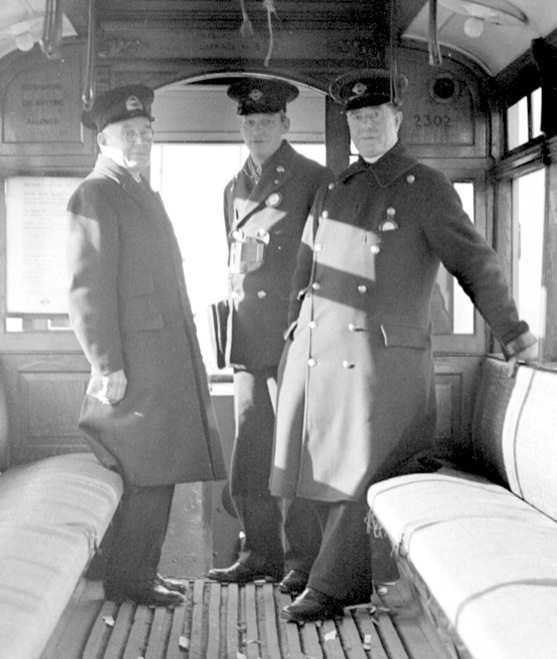
A Regulator or Section Inspector, a conductor and a motorman pose for the camera inside Tramcar 2302 on the 20th February 1938. Both the latter are wearing Metropolitan Stage Carriage badges on their left breasts (these were introduced in 1935), suspended from a uniform button. Photographer, D W K Jones. With thanks to the National Tramway Museum. 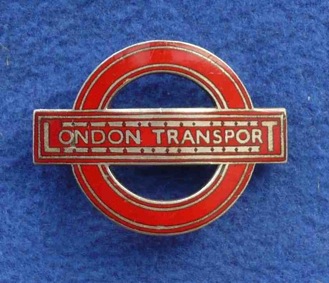
Standard LPTB tramcar crew cap badge — nickel/red enamel (issued to tramway staff from mid-1934 to May 1952). Author's Collection.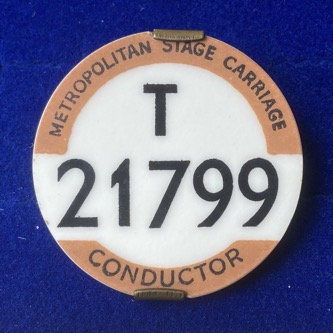
Metropolitan Stage Carriage badge — Conductor — introduced in 1935 and used right through to closure of the tramway in 1952. The designation 'T' was used for tramway and trolleybus staff. Author's Collection.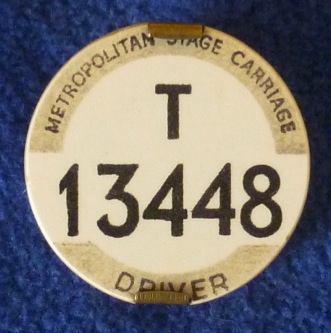
Metropolitan Stage Carriage badge — Driver. Author's Collection.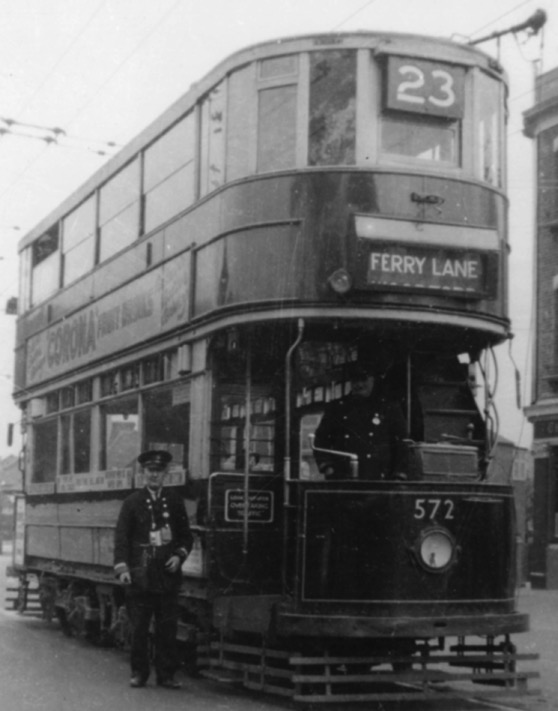
Tramcar No 572 and crew on a Route 23 service between Tottenham (Ferry Lane) and Woodford, possibly standing at Woodford — photo undated, but probably taken in the 1940s. The conductor is wearing the standard jacket with cuff bands of a lighter colour, and the motorman is wearing a lancer-style greatcoat. Photo courtesy of the Tramways and Light Railway Society, with thanks to David Voice.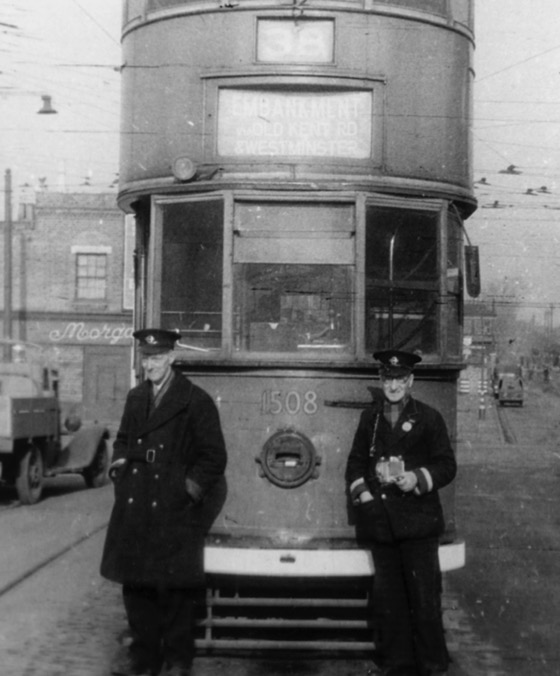
The crew of Tramcar No 1508 pose for the cameraman on a Route 38 service between Victoria Embankment and Abbey Wood — photo undated, but possibly taken in the late 1940s. The motorman is in an unmarked greatcoat (no longer of a lancer style), whilst the conductor is wearing the standard jacket (with light-coloured cuff bands, to aid him being seen at night) and a tartan scarf (a non-standard item). Photo courtesy of the Tramways and Light Railway Society, with thanks to David Voice.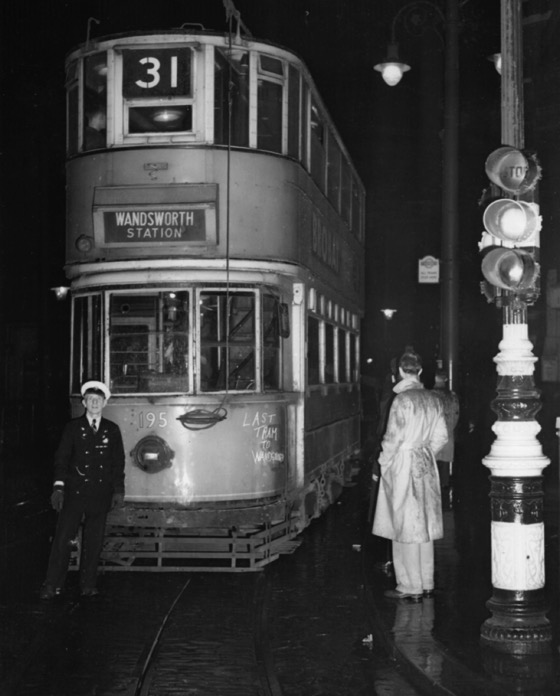
An evocative photo of Tramcar No 195 on a rainy London evening with the last ever service to Wandsworth (Route No 31 from Hackney) — photo probably taken on Saturday 30th September 1950. Photo courtesy of the Tramways and Light Railway Society, with thanks to David Voice.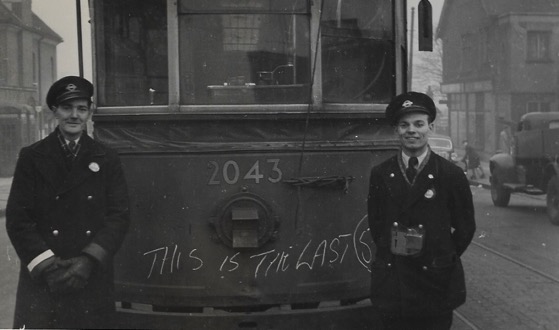
The motorman and conductor of Tramcar No 2043 (once of Walthamstow Council Light Railways) pose with their charge at Grove Park with the last ever Route 52 service, on 5th January 1952. Photo courtesy of the Dave Jones Collection.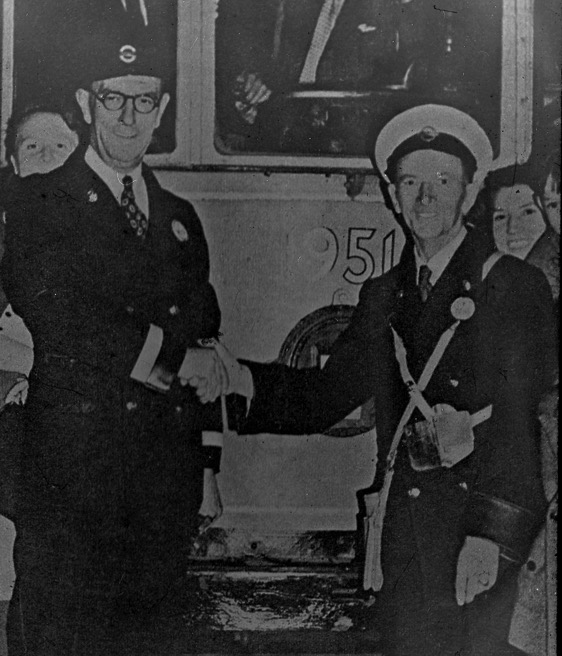
Motorman Albert Fuller (wearing a Central Buses cap badge) and Conductor Bedford shake hands in front of Tramcar No 1951 on the 5th of April 1952. Unusually. Conductor Bedford's jacket does not bear any cuff bands. With thanks to the National Tramway Museum. 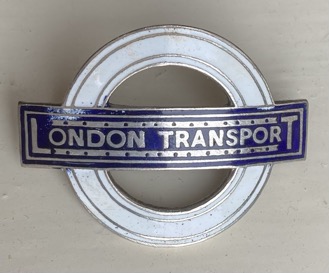
An LPTB Central Buses cap badge — nickel/deep blue and white enamel (issued to some tramway staff between 1950 and 1952). Author's Collection.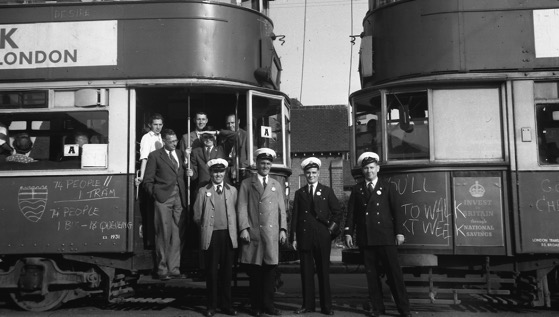
The crew of ex-LCC Tramcar No 1931 and sister car 1908 pictured on what is believed to a Light Railway Transport League tour during the last tram week, possibly on the last day. Photo taken by J H Price, courtesy of the Tramways and Light Railway Society, with thanks to David Voice.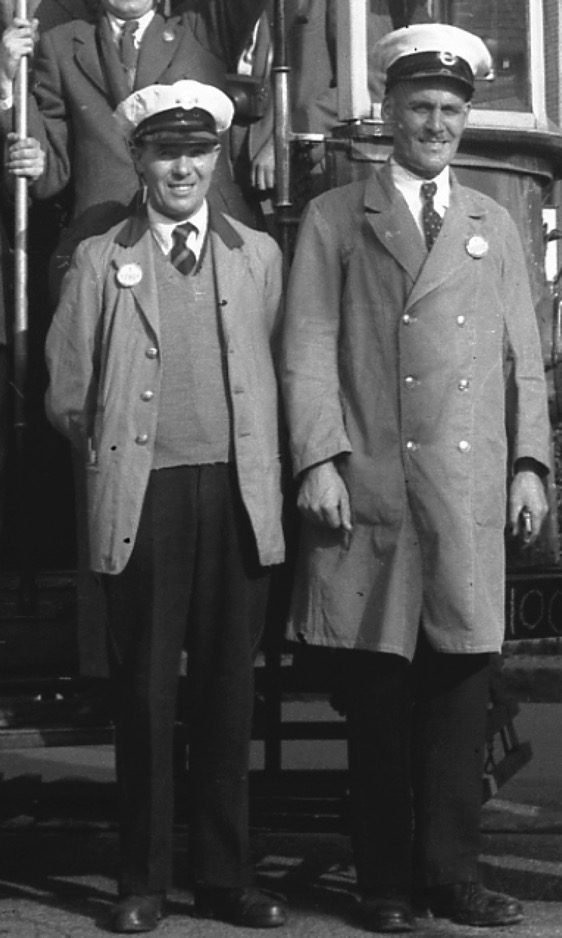
An enlargement of the above photograph showing the crew on the left, both in dust coats, one short with coloured collars and the other long. Apart from the buttons and the Metropolitan Stage Carriage badges, there would appear to be no other markings.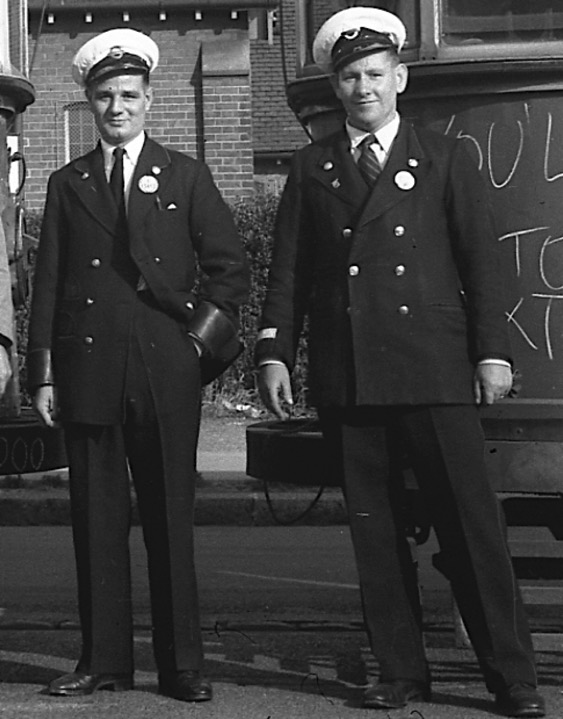
Another enlargement of the above photograph, this time showing the crew on the right, in the standard uniform jacket. The man on the right is wearing a Central Buses cap badge, with which Trams & Trolleybuses had merged in 1950 to form Central Road Services. 
A photograph taken on or around the last day of operation, the 5th July 1952, showing the Crew of Tramcar No 337 (ex West Ham Corporation Tramways) on Service 46. Photo courtesy of the Stephen Howarth Collection.
An enlargement of the above photograph showing the motorman (Metropolitan Stage Carriage badge T10844) and the conductor (Metropolitan Stage Carriage badge T18671). Both men are wearing Central Buses cap badges.
Senior staff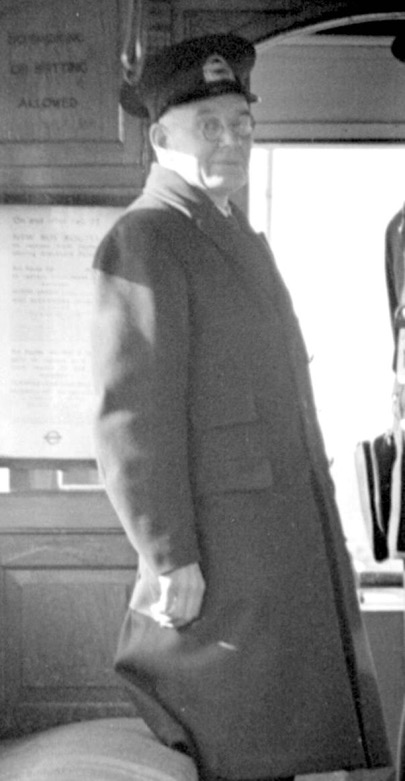
An enlargement of the 1935 photograph above showing an individual who is in all probability a Section Inspector or Regulator.
Section Inspector and Regulator cap badge — solid silver/red enamel (issued to tramway staff from mid-1934 to May 1952). The same badge was also worn by Driving Instructors until 1942.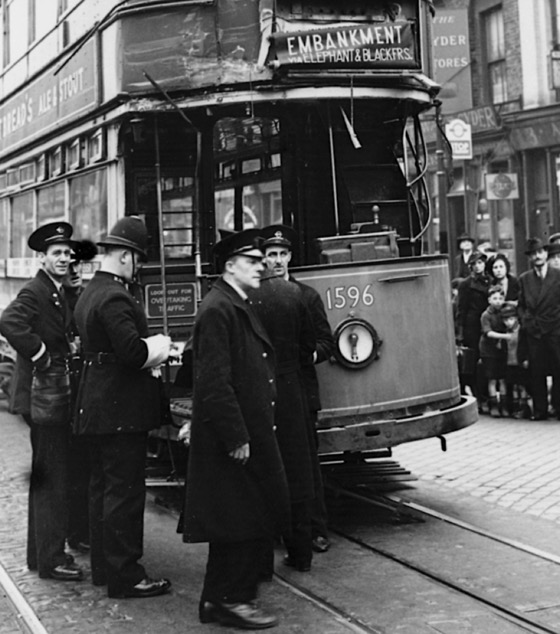
Nearest the camera, a Regulator or Section Inspector (probably), presides over the aftermath of what would appear to have been a fairly violent collision involving Tramcar No 1596 — photo undated, but possibly taken in the 1940s. Photo courtesy of the Tramways and Light Railway Society, with thanks to David Voice.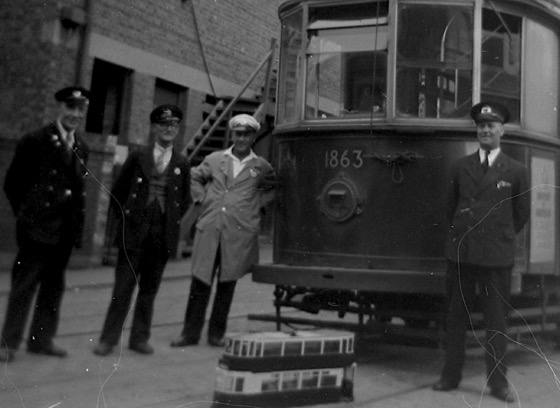
A District Inspector (probably) poses along with depot staff, Tramcar No 1863 and a model tram — photo undated, but probably taken in the early 1950s. He is wearing a double-breasted, suit-like jacket, which would appear to be without markings of any kind. Photo courtesy of the Tramways and Light Railway Society, with thanks to David Voice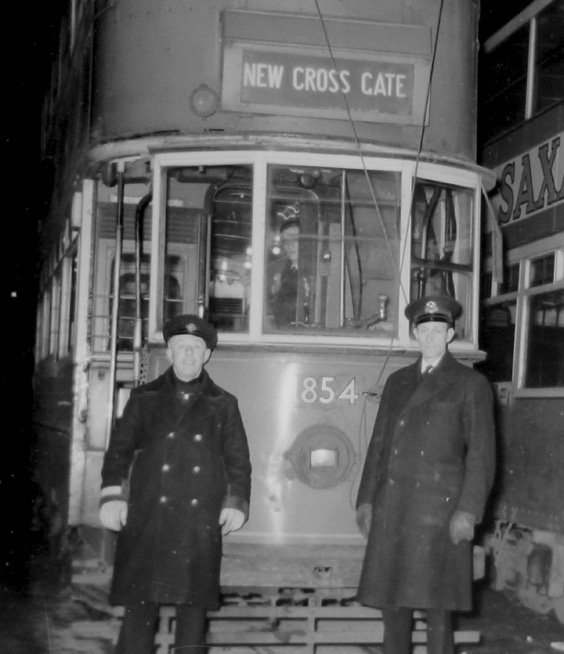
A Regulator, Section or District Inspector (right) with Tramcar No 1854 — photo undated, but probably taken in the early 1950s. Photo courtesy of the Tramways and Light Railway Society, with thanks to David Voice.
District Inspector cap badge — gold-plate silver/red enamel (issued to tramway staff from mid-1934 to May 1952); this grade was retitled Road Inspector from 1950, following the merger with Central Buses. This badge was also used by Senior Instructors, the Assistant Chief Instructor and the Chief Instructor from 1934 to 1946, as well as Divisional Mechanical Inspectors from 1948 to through to 1950.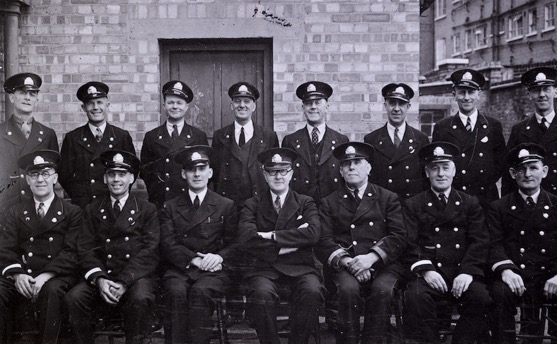
The entire staff of Clapham Motor School, an establishment that was responsible for training all the LPTB's motormen up until 1950 — photo thought to have been taken around 1948. Back Row (left to right): A Sharman, unknown, unknown, unknown, Stan Collins, unknown, unknown, unknown; all are Driving Instructors. Front Row (left to right): F Hancock, C Holman, Reg Wakelin (Assistant Chief Driving Instructor and Examiner), Edward Wallis (Tram Chief Driving Instructor and Examiner), unknown, unknown, unknown; with the exception of Edward Wallis and Reg Wakelin, all are Driving Instructors. Photo courtesy of the David Lawrence Collection.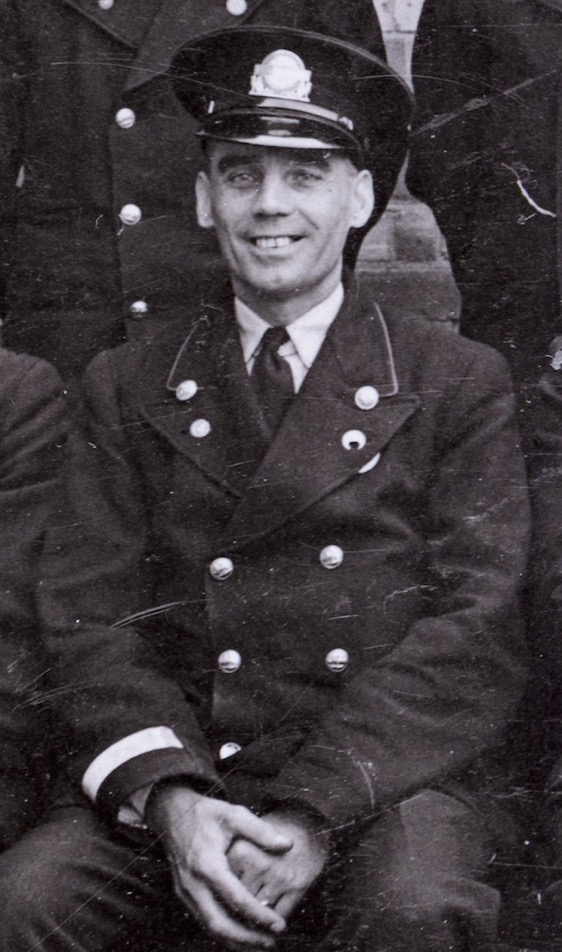
A blow-up of the above photograph showing Driving Instructor C Holman. His jacket is double-breasted with two rows of four metal 'griffin' buttons and a light-coloured band on his right sleeve cuff, possibly reflective (all the Driving Instructors had these). The cap badges worn by all Driving Instructors were nickel with a red bullseye and a blue enamel centre containing the word 'INSTRUCTOR'.
Driving Instructor cap badge — nickel/red and blue enamel (issued to tramway staff from 1946 to 1952). 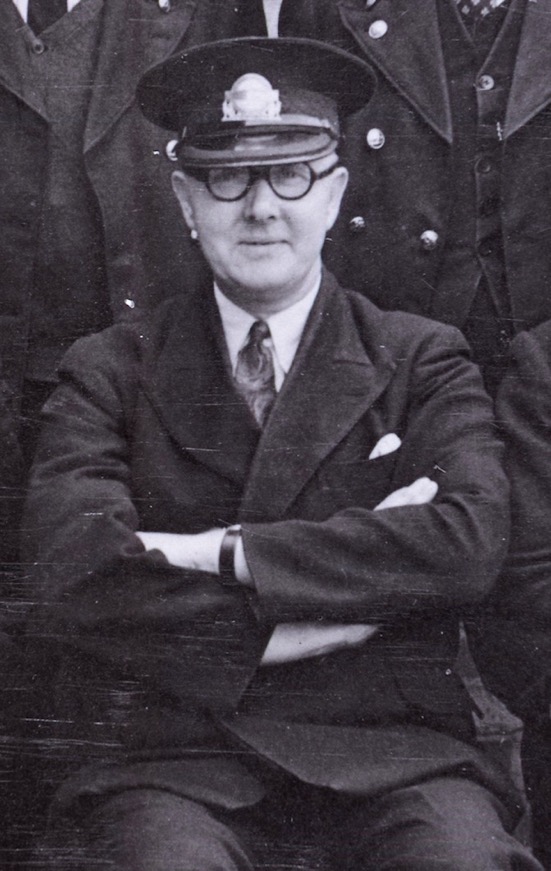
Another enlargement of the above photograph, this time showing the Chief Driving Instructor and Examiner, Edward Wallis. His jacket is double-breasted with plain buttons (or possibly black composite). His cap badge was apparently gold with a red bullseye and a blue enamel centre; it is unclear whether this badge bore 'INSTRUCTOR' lettering.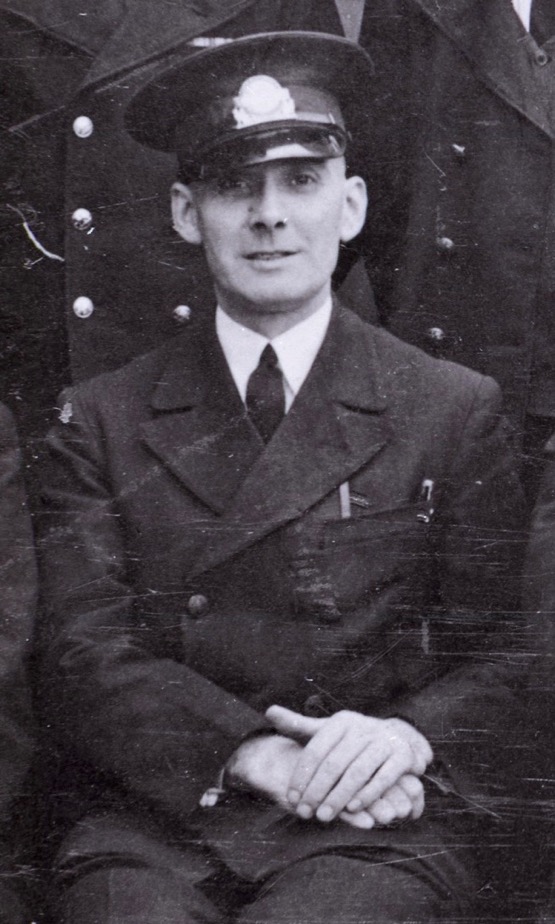
One last blow-up of the above photograph showing the Assistant Chief Driving Instructor and Examiner, Reg Wakelin. His jacket and cap badge were possibly identical to that worn by the Chief Driving Instructor and Examiner.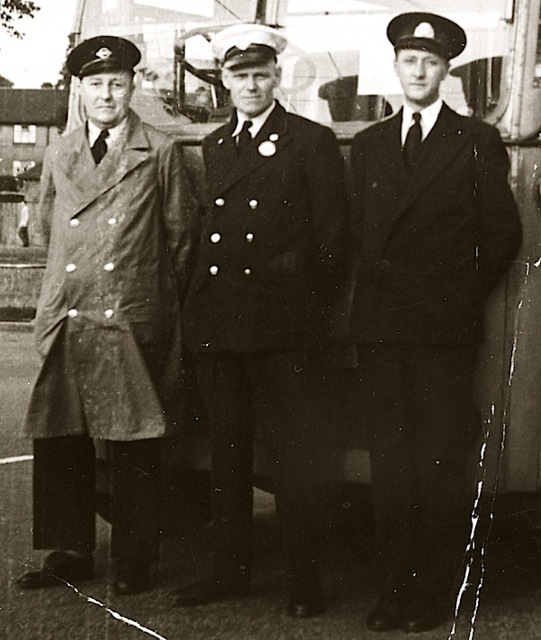
Three staff pose for the camera in front of the LPTB's famous twin front axle trolleybus, No 1671 — photo taken circa 1948. The man on the right is the first 'tram' Divisional Mechanical Inspector, Bob Brown. Photo courtesy of the David Lawrence Collection.
Divisional Mechanical Inspector cap badge — white metal/red and white enamel (1948 until 1950).
Female staff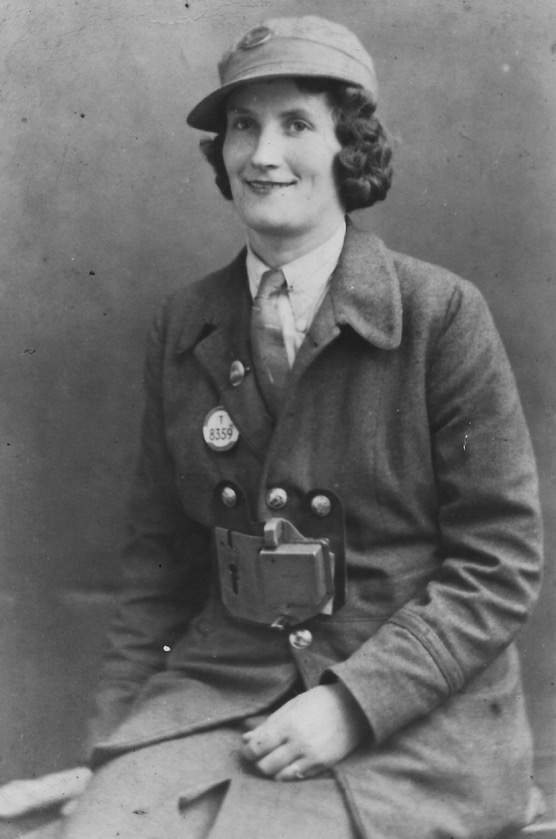
A studio portrait of a Second World War Tram/Trolleybus conductress, bearer of Metropolitan Stage Carriage Badge No 8359. The uniform is the type first issued, being made of grey serge. Photo courtesy of the LCC Tramways Trust Collection, with thanks to Dave Jones.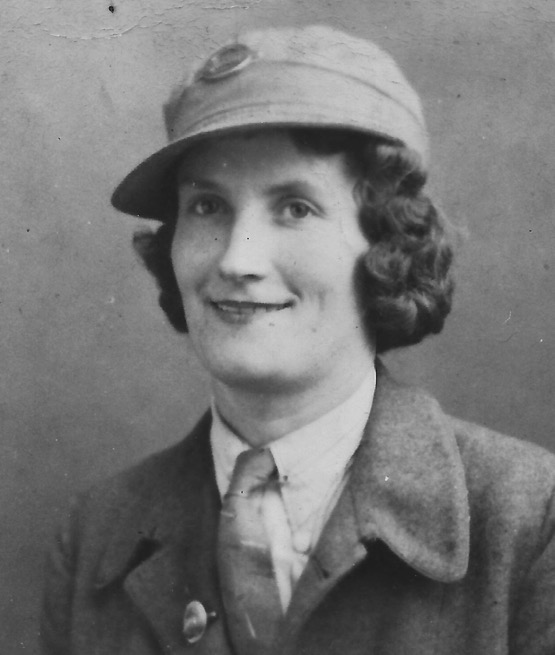
An enlargement of the above photograph showing the cap, which carries a standard LPTB Tramways/Trolleybuses cap badge. The round object on her right lapel is actually a button, from which her MSC badge is suspended.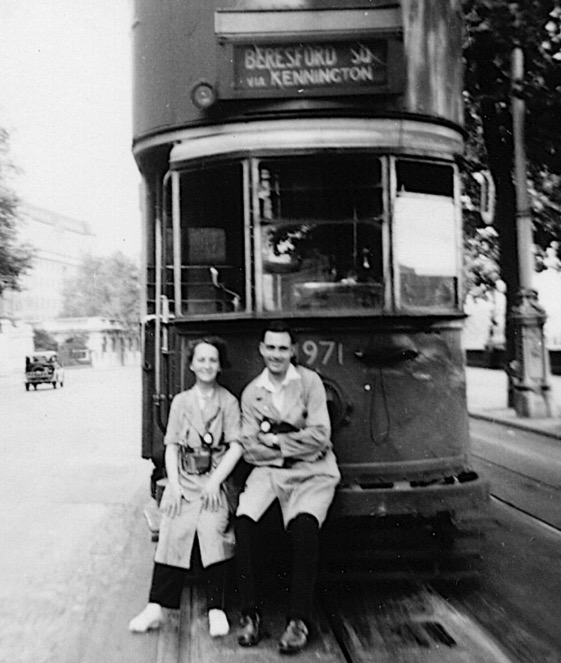
Frustratingly out of focus, but included here because it is the only photo I have been able to source that shows an LPTB conductress at work — photo undated, but probably taken in the late 1940s or early 1950s. The tram is No 1971, and it is captured on Victoria Embankment on a Route 40 service to Abbey Wood. Both the conductress and the motorman are wearing light-coloured, cotton dust coats, seemingly devoid of insignia, save for the Metropolitan Stage Carriage badges. Photo courtesy of the Tramways and Light Railway Society, with thanks to David Voice.
London Transport Military Band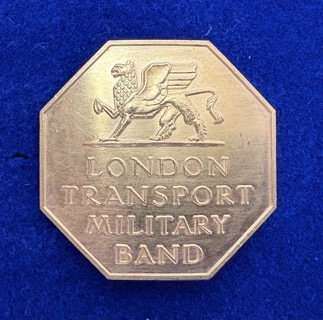
London Transport Military Band cap badge — brass (1933 to c1948). Author's Collection.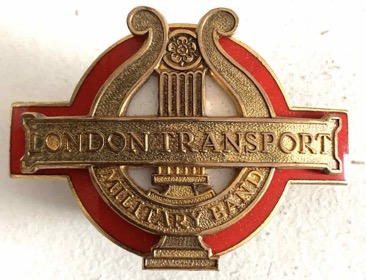
London Transport Military Band cap badge — brass and red enamel (c1948 onwards). Photo courtesy of the Robin Newell Collection.